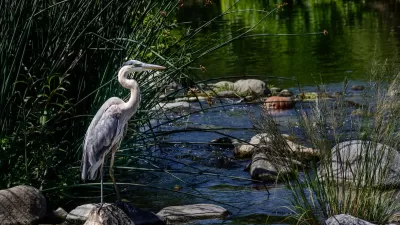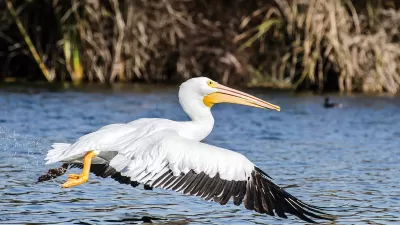From its mountain tributaries, to the San Fernando Valley, through Downtown, and across the basin into the Pacific Ocean, Christian MilNeil tells the story behind the ecological and recreation rehabilitation of the Los Angeles River.
Unarguably one of the region's most photographed and filmed landmarks, the Los Angeles River's miles of concrete-lined channels have appeared in numerous films, advertisements, and music videos. Now advocates are hoping to rehabilitate the river's post-apocalyptic appearance by tying in aspects of ecology and livability.
Christian MilNeil, writing for Grist, takes the reader on a four-part tour of the river, from its start in the mountains above the San Fernando Valley to its mouth in Long Beach. Perhaps most interesting are his comments regarding how residents and visitors to the city interact with their river, from the sprawling and busy Sepulveda Dam Recreation Area, where the unpaved river returns to its wild roots for a short stretch, to the lifeless Confluence Park in the Glassel Park neighborhood, near the tangle of highway interchange viaducts that fly over the historic confluence of the L.A. River and the Arroyo Seco.
Then there's the famed stretch just east of Downtown Los Angeles, with its art deco bridges, power lines, railroads, and near-complete isolation from the rest of the city. Here, many of the most interesting and largest plans to rehab the river are taking place. Plans include "re-wilding" the river with an unpaved bottom and lining its banks with parks and redevelopment. And though "[a]ll this sounds pretty good to sustainability advocates - and to a growing number of political leaders..., until Los Angeles embraces those broader changes...restoration efforts like the one at Tujunga Wash [in the San Fernando Valley] will end up spending more tax money...to achieve less."
Read more about the Los Angeles River in MilNeil's four-part series in Part 1, Part 2, Part 3, and Part 4.
FULL STORY: Los Angeles River checks into rehab

Alabama: Trump Terminates Settlements for Black Communities Harmed By Raw Sewage
Trump deemed the landmark civil rights agreement “illegal DEI and environmental justice policy.”

Planetizen Federal Action Tracker
A weekly monitor of how Trump’s orders and actions are impacting planners and planning in America.

Why Should We Subsidize Public Transportation?
Many public transit agencies face financial stress due to rising costs, declining fare revenue, and declining subsidies. Transit advocates must provide a strong business case for increasing public transit funding.

Understanding Road Diets
An explainer from Momentum highlights the advantages of reducing vehicle lanes in favor of more bike, transit, and pedestrian infrastructure.

New California Law Regulates Warehouse Pollution
A new law tightens building and emissions regulations for large distribution warehouses to mitigate air pollution and traffic in surrounding communities.

Phoenix Announces Opening Date for Light Rail Extension
The South Central extension will connect South Phoenix to downtown and other major hubs starting on June 7.
Urban Design for Planners 1: Software Tools
This six-course series explores essential urban design concepts using open source software and equips planners with the tools they need to participate fully in the urban design process.
Planning for Universal Design
Learn the tools for implementing Universal Design in planning regulations.
Caltrans
Smith Gee Studio
Institute for Housing and Urban Development Studies (IHS)
City of Grandview
Harvard GSD Executive Education
Toledo-Lucas County Plan Commissions
Salt Lake City
NYU Wagner Graduate School of Public Service




























